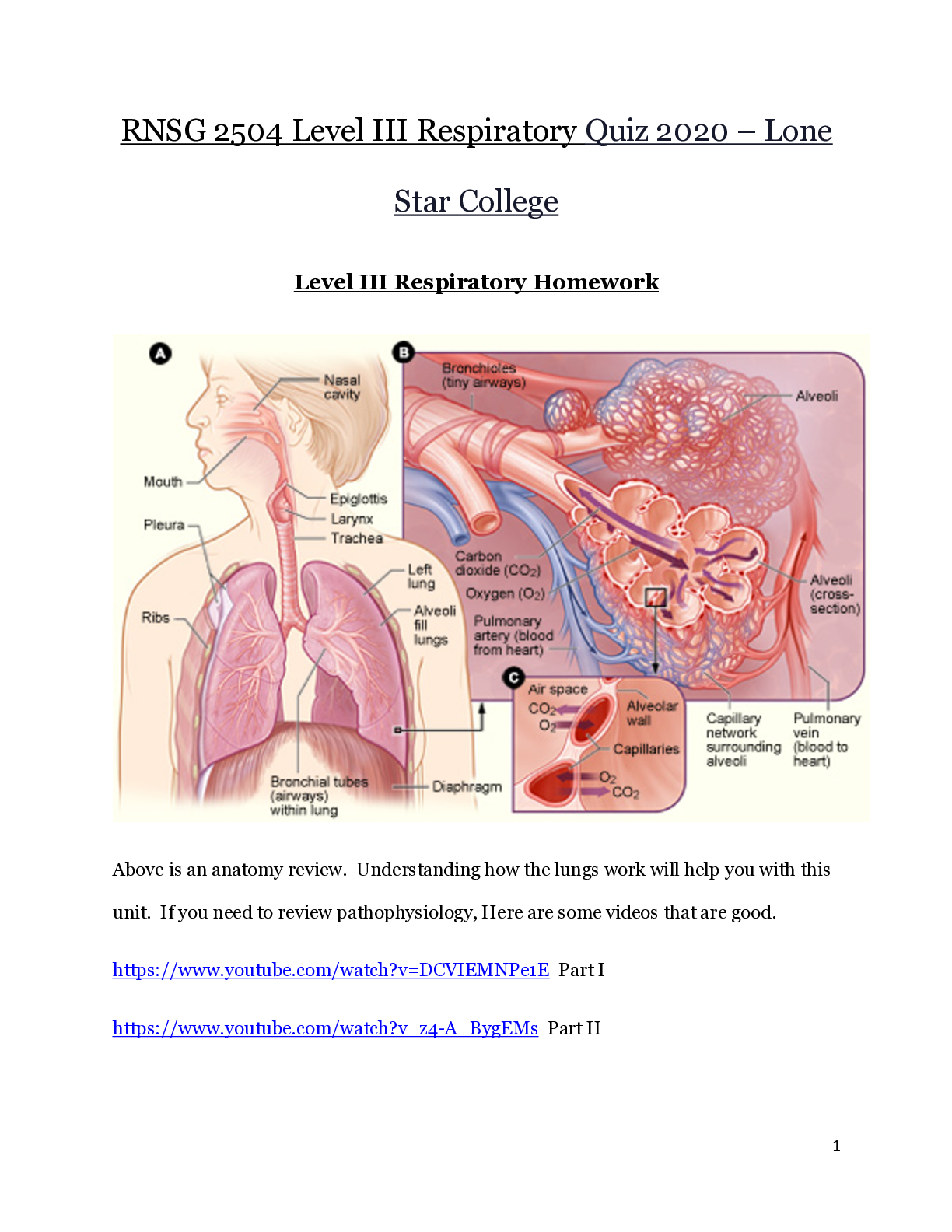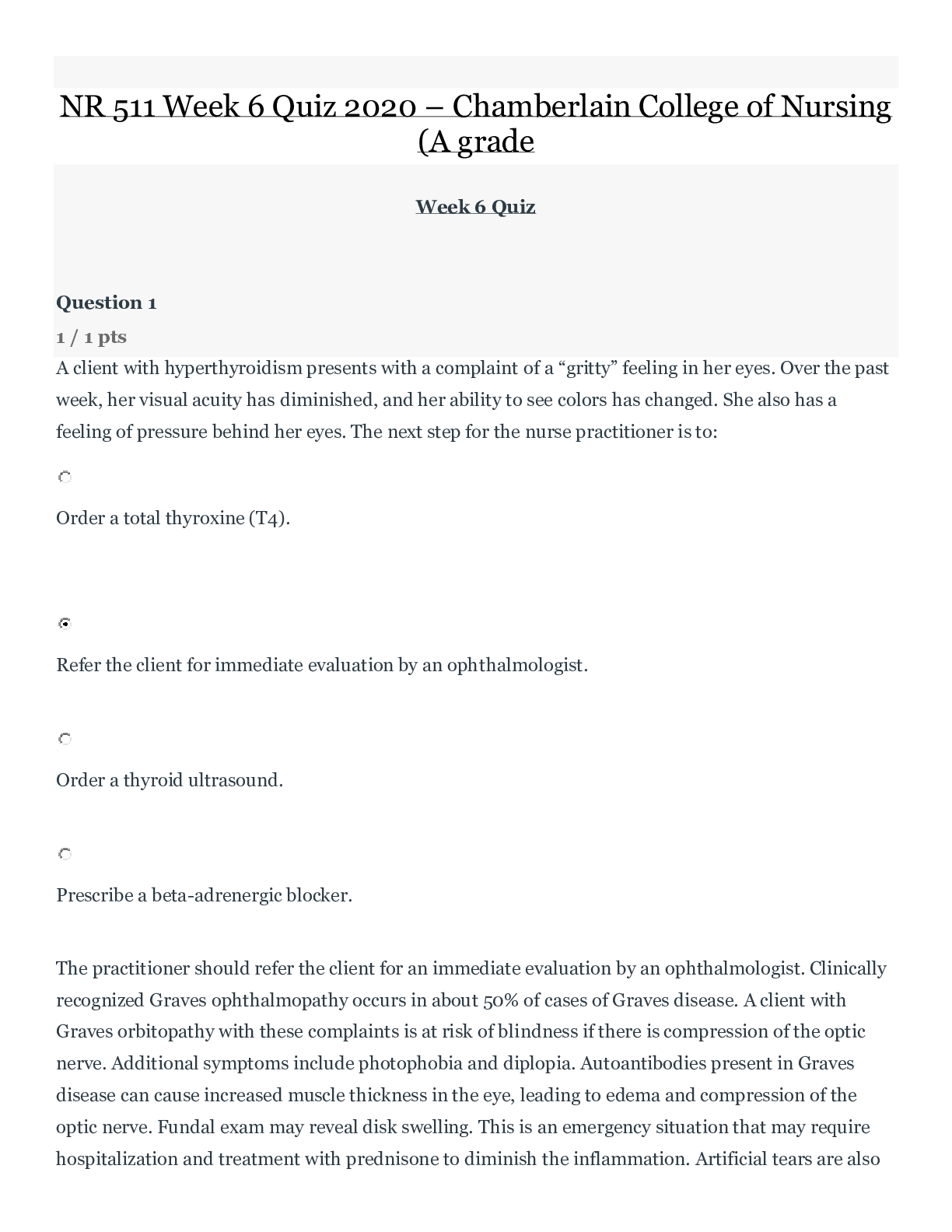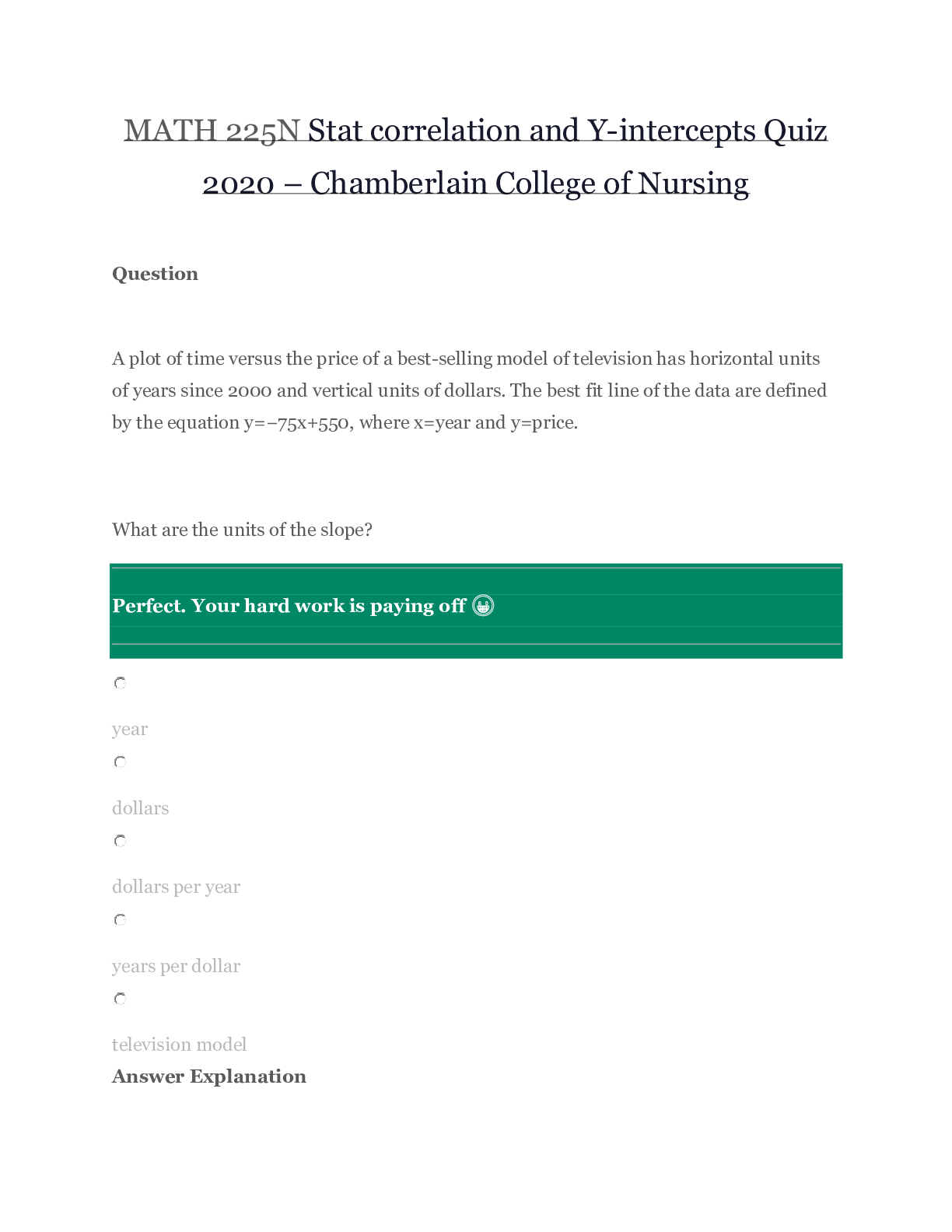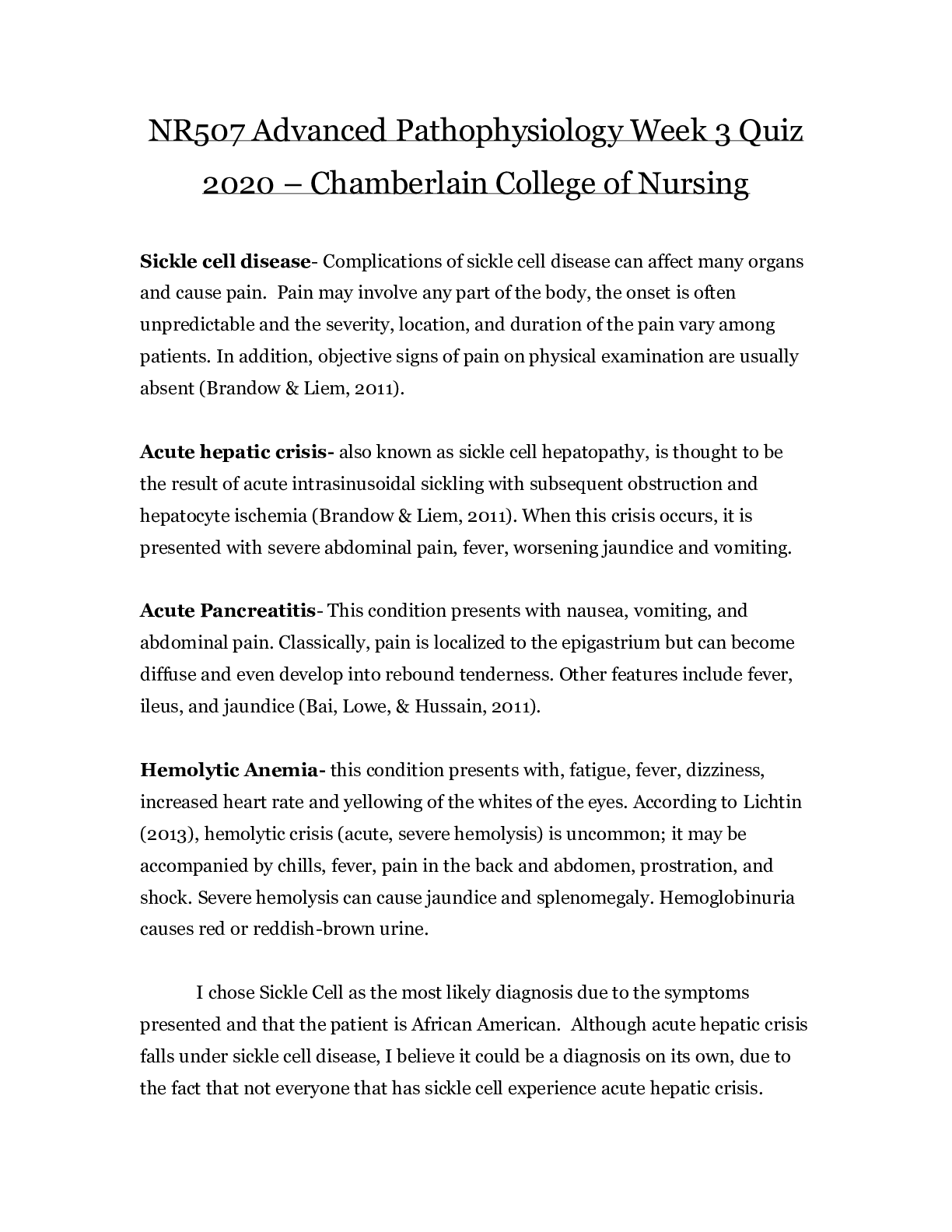*NURSING > EXAM > RNSG 2504 Level III Respiratory Quiz 2020 – Lone Star College | RNSG2504 Level III Respiratory Qui (All)
RNSG 2504 Level III Respiratory Quiz 2020 – Lone Star College | RNSG2504 Level III Respiratory Quiz 2020
Document Content and Description Below
RNSG 2504 Level III Respiratory Quiz 2020 – Lone Star College RNSG 2504 Level III Respiratory Quiz 2020 Level III Respiratory Homework Above is an anatomy review. Understanding how the lungs w... ork will help you with this unit. If you need to review pathophysiology, Here are some videos that are good. https://www.youtube.com/watch?v=DCVIEMNPe1E Part I https://www.youtube.com/watch?v=z4-A_BygEMs Part II How is ventilation controlled by the body? If a patient is getting 3 L/m of oxygen, what percentage of oxygen does that equate to? What is the max flow rate for nasal cannula oxygen? What is the most accurate to deliver oxygen (externally, not through an ET tube)? - - - - - - - - - - - - - - - - - - - - Describe some measures to improve oxygenation in ARDS? What is the survival rate? Is there permanent damage? How do you describe ARDS to a non-medical family member? Watch video: https://www.youtube.com/watch?v=tarWCSbdcGA sorry there isn’t a part II. What are the indicators for an ET tube? How long can you have an ET tube? Why? Explain the documentation for an ET tube? What are the indicators for mechanical ventilation? What can a ventilator do for your patient? (yes, I know it breathes, but what else) What is the “train of four”? What is PEEP? Why can it help? How would I know that someone is ready to come off the ventilator? Explain what causes the low and high pressure alarms for a patient on the ventilator in the chart below. Low Pressure Alarms High Pressure Alarms What is VAP? What are measures to try to prevent VAP? What is a flail chest? What is the hallmark sign of a tension pneumothorax? Don’t freak out over the ventilators!!! Chest Trauma/Rib fracture/ Hemo/pnemo thorax/Pulmonary Contusion/empyema- Read pages 594, 610-615 Also all things chest tubes are fair game for testing. Read 504-520 for Intubation, ventilation, airway obstruction, tracheostomy Shock Shock is a life-threatening condition that results from inadequate tissue perfusion. Many conditions may cause shock; irrespective of the cause, tissue hypoperfusion prevents adequate oxygen delivery to cells, leading to cell dysfunction and death. The progression of shock is neither linear nor predictable, and shock states, especially septic shock, comprise an area of aggressive clinical research. Nurses caring for patients with shock and those at risk for shock must understand the underlying mechanisms of the various shock states (i.e., hypovolemic, cardiogenic, obstructive (see Chapter 29), neurogenic, anaphylactic, and septic) and recognize the subtle as well as more obvious signs of each of these states. Rapid assessment with early recognition and response to shock states is essential to the patient’s recovery. Regardless of the initial cause of shock, certain physiologic responses are common to all types of shock. These physiologic responses include hypoperfusion of tissues, hypermetabolism, and activation of the inflammatory response. The body responds to shock states by activating the sympathetic nervous system and mounting a hypermetabolic and inflammatory response. Failure of compensatory mechanisms to effectively restore physiologic balance is the final pathway of all shock states and results in end-organ dysfunction and death (Dellinger, Levy, Rhodes, et al., 2013; Maier, 2015; Wacker & Winters, 2014). Pathophysiology Understand the cellular changes, vascular responses and blood pressure regulation Stages of Shock Compensatory In the compensatory stage of shock, the BP remains within ___________ ___________. Vasoconstriction, ____________ heart rate, and increased contractility of the heart contribute to maintaining adequate cardiac output. This results from stimulation of the sympathetic nervous system and subsequent release of catecholamines (epinephrine and norepinephrine). Patients display the often-described “fight-or-flight” response. The body shunts blood from organs such as the skin, kidneys, and gastrointestinal (GI) tract to the brain, heart, and lungs to ensure adequate blood supply to these vital organs. As a result, the skin may be ______ and ________, bowel sounds are ____________, and urine output ____________ in response to the release of aldosterone and ADH. What is the nurse’s role in detecting the compensatory stage of shock? - - - - - - - - - - - - - - - - - - - - - - - Blood Pressure Despite treatment, BP remains low. Heart Rate The heart rate is rapid, sometimes exceeding 150 bpm. Respiratory Status Respiratory system dysfunction prevents adequate oxygenation and ventilation despite mechanical ventilatory support, and the cardiovascular system is ineffective in maintaining an adequate MAP for tissue perfusion. Skin Bruises (ecchymoses) and bleeding (petechiae) may appear in the skin. Urine Output Urinary output usually decreases to less than 0.5 mL/kg per hour (or less than 30 mL per hour) but may vary depending on the phase of AKI. Mentation Initially, the patient may exhibit subtle changes in behavior, become agitated, confused, or demonstrate signs of delirium. Acid-Base Balance Decreased pulmonary blood flow causes arterial oxygen levels to decrease and CO2 levels to increase. General Strategies to Treat Shock Medication Desired Action in Shock Disadvantages Inotropic Agents Dobutamine Stimulates heart’s beta1 receptors to increase myocardial contractility and stroke volume. At therapeutic dosages, drug increases cardiac output by decreasing peripheral vascular resistance, reducing ventricular filling pressure, and facilitating AV node conduction. Because drug increases AV node conduction, patients with atrial fibrillation may develop a rapid ventricular rate. Dopamine Stimulates dopaminergic and alpha and beta receptors of the sympathetic nervous system, resulting in a positive inotropic effect and increased cardiac output. Action is dose-related; large doses cause mainly alpha stimulation. hypotension, ventricular arrhythmias (high doses) Epinephrine Relaxes bronchial smooth muscle by stimulating beta2 receptors and alpha and beta receptors in the sympathetic nervous system. widened pulse pressure, cerebral hemorrhage, stroke, anginal pain, cardiac arrhythmias, altered ECG (including decreased T-wave amplitude Milrinone Produces inotropic action by increasing cellular levels of cAMP and vasodilation by relaxing vascular smooth muscle. Use of milrinone for more than 48 hours in patients with HF hasn’t been shown to be safe or effective. Drug has been associated with increased frequency of ventricular arrhythmias, including nonsustained ventricular tachycardia and supraventricular and ventricular arrhythmias in the high-risk population. Closely monitor patient. Vasodilators Nitroglycerin Reduces cardiac oxygen demand by decreasing left ventricular end-diastolic pressure (preload) and, to a lesser extent, systemic vascular resistance (afterload). Also increases blood flow through the collateral coronary vessels. headache, dizziness, syncope, weakness. dyspnea. Nitroprusside Relaxes arteriolar and venous smooth muscle. Drug can cause severe hypotension, which can lead to ischemic injuries or death. Use drug only when available equipment and personnel allow BP to be continuously monitored Vasopressor Agent Norepinephrine Stimulates alpha and beta1 receptors in the sympathetic nervous system, causing vasoconstriction and cardiac stimulation. respiratory difficulties Phenylephrine Causes local vasoconstriction of dilated arterioles, reducing blood flow temporary discomfort, such as burning, stinging, sneezing, or an increase in nasal discharge, may occur. Vasopressin Causes contraction of smooth muscle in the vascular bed and increases systemic vascular resistance and mean arterial BP and decreases HR and cardiac output. Use in patients with impaired cardiac response may worsen cardiac output. Types of Shock Cardiogenic Shock What are the two categories? Coronary or non-coronary What nursing interventions can the nurse anticipate with cardiogenic shock client? Preventing Cardiogenic Shock • Identifying at-risk patients early: promoting adequate oxygenation of the heart muscle, and decreasing cardiac workload can prevent cardiogenic shock. o Conserve the patient’s energy o Promptly relieve angina o Administer supplemental oxygen Monitoring Hemodynamic Status • Arterial lines and ECG monitoring equipment must be well maintained and functioning properly. • The nurse anticipates the medications, IV fluids, and equipment that might be used and is ready to assist in implementing these measures. • Changes in hemodynamic, cardiac, and pulmonary status and laboratory values are documented and reported promptly • Adventitious breath sounds, changes in cardiac rhythm, and other abnormal physical assessment findings are reported immediately - - - - - - - - - - - - - - - - - - - - - - - Severe sepsis: the presence of signs and symptoms of sepsis associated with organ dysfunction, hypotension, and/or hypoperfusion; clinical signs and symptoms include those of sepsis as well as: 1. lactic acidosis 2. oliguria 3. altered LOC 4. thrombocytopenia and DIC 5. altered hepatic function Multiple Organ Dysfunction Syndrome (MODS) In MODS, the sequence of organ dysfunction varies depending on the patient’s primary illness and comorbidities prior to experiencing shock. Advanced age, malnutrition, and coexisting disease appear to increase the risk of MODS in acutely ill patients. For simplicity of presentation, the classic pattern is described. Typically, the lungs are the first organs to show signs of dysfunction. The patient experiences progressive dyspnea and respiratory failure that is manifested as ALI or - -- - - - - - - - - - - - - - - - -ARDS, requiring intubation and mechanical ventilation. The patient usually remains hemodynamically stable but may require increasing amounts of IV fluids and vasoactive agents to support BP and cardiac output. What are the signs of a hypermetabolic state? • Hyperglycemia, hyperlactic academia, increased BUN What is similar with a client in Irreversible Stage of shock and MODS? • Hyperlactic acidemia [Show More]
Last updated: 2 years ago
Preview 1 out of 25 pages

Buy this document to get the full access instantly
Instant Download Access after purchase
Buy NowInstant download
We Accept:

Reviews( 0 )
$14.50
Can't find what you want? Try our AI powered Search
Document information
Connected school, study & course
About the document
Uploaded On
Nov 03, 2020
Number of pages
25
Written in
Additional information
This document has been written for:
Uploaded
Nov 03, 2020
Downloads
0
Views
37








 – University of the People.png)

















